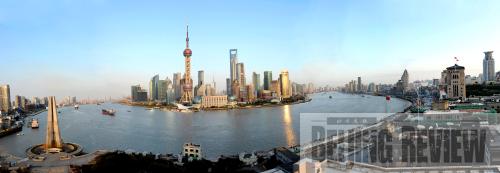|
 |
|
OUTLOOK: The full view of Shanghai's Bund on March 29, 2009 The author is a marketing director for an IT company in Shanghai (CFP) |
Before I came to Shanghai, I used to think the Bund was just a long corridor alongside the Huangpu River facing the city's central business district of Lujiazui in Pudong New Area. After checking the map, I got to know that the Bund refers to the long narrow strip extending 1.2 km from Waibaidu Bridge to East Yan'an Road.
In 1846, the British Consulate rented a piece of low-lying land along the Huangpu River to build apartments and shops for his country's citizens. In the same year, British firm Jardine Matheson opened its branch in Shanghai, becoming the first foreign company settled there.
In 1847, Shanghai witnessed its first foreign bank, Oriental Bank, setting up a branch. Thereafter many other foreign banks rushed in, including the Hong Kong and Shanghai Banking Corp. (HSBC), Germany's Deutsch-Asiatische Bank, Japan's Yokohama Specie Bank, and others from Russia, France and the United States.
When the People's Republic of China was founded in 1949, there were more than 600 foreign banks and 4,000 registered foreign commercial groups, making the Bund the largest international trade and financial center in China. Shanghai's financial sector ranked third in the world behind London and New York, and it had the reputation of being the "Wall Street of the Far East."
The Bund has a mixed architectural style due to the array of diverse characteristics there: baroque, Roman-style, Gothic and a blending of Eastern and Western styles. People used to say the Bund exhibits 17 classic European architectural styles from Britain, Holland, Norway, Russia, Germany, Austria and others. The building of HSBC, which was completed in 1923, covers the largest area among the foreign architecture of the district.
In recent years, Shanghai has erected other modern skyscrapers. Though they are designed by different groups, their basic colors and overall skyline mix well with each other. Taking a walk along the Huangpu River, one doesn't see the old and new buildings as mismatched.
I still remember years ago when I first came to Shanghai, I asked the taxi driver for tourism advice. "For outsiders in Shanghai, there are several things that can't be missed—the steamed buns at Chenghuang Temple (or the City God Temple), Nanjing Road, the Bund and the sight of the Oriental Pearl Tower at night." I committed all these places to memory and thought they represented their city in the eyes of the locals.
Following the taxi driver's advice, I toured the route and found these places were not far from each other. In fact, they can be done in just one day. From the narrow and shabby alleys to the glamorous and magnificent modern architecture, it was like a walk into history.
For my second tour to Shanghai, I found the definition of the Bund had changed. The locals called the Bund along the west side of the Huangpu River the Old Bund, where tens of thousands of tourists from all over the world come to see the hundred-year-old buildings. It was too crowded to even find a place to have a rest there. Street peddlers were selling all kinds of goods, from drinks to post cards to boiled corn. That was the Old Bund, a miniature of all the city street scenes of a developing country.
|
